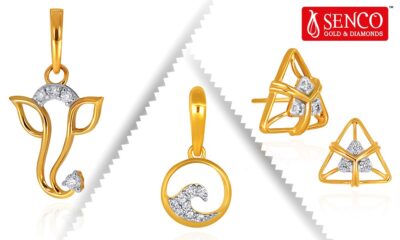DiamondBuzz
De Beers CEO Al Cook: India’s Natural Diamond Market to Hit $20 Billion by 2030 Amid Rising Demand

India’s natural diamond market is poised for a major leap, with De Beers Group CEO Al Cook projecting the market will double in value—from nearly $10 billion today to $20 billion by 2030. Cook shared this vision during his first official visit to India, speaking at a press event held at Taj Lands End, Mumbai.
“India is the heart and home of diamonds, and it’s now leading the world in diamond demand,” Cook said. Highlighting a 12% annual growth in demand, he credited the rise to India’s expanding middle class, increasing disposable incomes, and deep cultural affinity for natural diamonds. India currently processes 90% of the world’s diamonds and supports over one million jobs in the sector.
To tap into this momentum, De Beers is rolling out an ambitious, India-focused strategy. Its Forevermark brand will launch in Mumbai and Delhi in 2025, with plans to expand to over 100 outlets nationwide. The company will use a “cluster-based” approach, combining company-run and franchise stores with strong e-commerce integration. The offerings will target aspirational consumers, with an average ticket size of ₹2.5 lakh.
De Beers is also ramping up marketing efforts. Its “Love From Dad” campaign, celebrating family milestones, has resonated strongly with Indian consumers. Strategic partnerships with the Indian Premier League (IPL) and top jeweller Tanishq are deepening brand presence. De Beers is training thousands of Tanishq sales staff through its Institute of Diamonds in Surat to help customers understand the rarity and ethical sourcing of natural diamonds.
A major new initiative, INDRA, will launch in August in partnership with the Gem & Jewellery Export Promotion Council (GJEPC), with 1,700 retailers already showing interest. “We are shifting from ‘from and by India’ to ‘to and for India,’” said Cook, stressing the growing domestic appetite for natural diamonds.

Addressing the rise of lab-grown diamonds (LGDs), Cook noted that LGD prices have dropped by 90% and are now available for as little as $299 in the US. De Beers has since closed its Lightbox LGD business in the US. “Our job to distinguish natural diamonds from LGDs is done,” he said, underlining the brand’s renewed focus on natural stones.
To reinforce consumer trust, De Beers has introduced Diamond Proof, a tool that can verify natural diamonds in just three seconds with 100% accuracy. “It’s critical that consumers know what they’re buying,” Cook emphasized.
Sustainability remains central to De Beers’ growth model, with a company-wide goal of achieving carbon neutrality by 2030. Cook highlighted the adoption of solar energy by Indian diamond polishers in Surat, and De Beers’ own green energy initiatives in South Africa and Namibia, including a new wind energy deal.
Additionally, De Beers’ synthetic diamond arm, Element Six, is exploring applications for advanced technology sectors like 6G and quantum computing. Cook said India’s rapid emergence as a tech leader makes it an ideal partner, pointing to potential investments in the country’s semiconductor industry.
Cook also addressed global trade concerns, expressing optimism over securing tariff exemptions on natural diamond imports in the US-India trade talks. With no domestic diamond production in the U.S., such tariffs function only as consumer taxes, he argued.
De Beers’ vision for India goes beyond business. “India fell in love with diamonds 2,000 years ago, and that bond is stronger than ever,” Cook concluded, affirming De Beers’ long-term commitment to making India the epicenter of global natural diamond consumption.

DiamondBuzz
De Beers brings Diamonds and Glamour to London

Insiders suggest a star-studded journey to London might be on the cards. But why London? Beyond its glittering reputation as a global hub for jewellery and fashion, whispers point to something far more dazzling — De Beers is set to host a major showcase in the city.
This year, De Beers Group makes its grand debut at Frieze London, marking a landmark moment where the world of natural diamonds meets the world of art. In collaboration with Frieze Masters, the brand will unveil Voyage Through the Diamond Realm — an immersive experience said to capture the mystery, beauty, and brilliance of natural diamonds like never before.
To bring this vision to life, De Beers has invited India’s leading style and art connoisseurs, including Twinkle Khanna, Ananya Panday, Sara Tendulkar, Karan Johar and many more. Known for their refined taste and appreciation of art and design, these tastemakers are the perfect ambassadors to experience natural diamonds in a whole new light — where every facet tells a story of time, pressure, and perfection.
While details remain under wraps, those close to the brand hint that the experience will be nothing short of transformative — a moment where science, storytelling, and rarity converge to celebrate nature’s most extraordinary creations.
One thing’s certain: when De Beers Group meets Frieze London, the city is bound to shine a little brighter — and perhaps, so will those boarding that flight.
-

 National News2 hours ago
National News2 hours agoSenco Gold & Diamonds launches affordable 9k gold jewellery starting under ₹7,000, a Game-changer amid fluctuating gold prices this Dhanteras
-

 Education3 hours ago
Education3 hours agoIndian jewellery trade and industry expectations & trends
-

 BrandBuzz2 hours ago
BrandBuzz2 hours agoMavitrra Launches “The Amara Collection” – A Timeless Celebration of Bridal Grandeur and Festive Luxury
-

 GlamBuzz6 hours ago
GlamBuzz6 hours agoDazzling Divas and Star Power: Inside Manish Malhotra’s Grand Diwali Celebration




